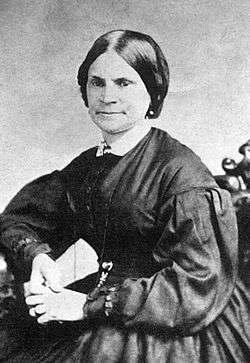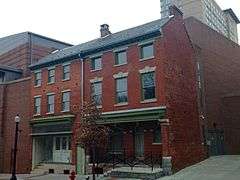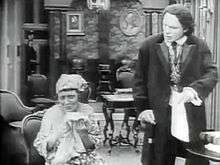Lydia Hamilton Smith
Lydia Hamilton Smith (February 14, 1813 – February 14, 1884) was the long-time housekeeper of Thaddeus Stevens and a prominent African-American businesswoman after his death.

Early life
Lydia Hamilton was born at Russell Tavern near Gettysburg in Adams County, Pennsylvania, US. She was one-quarter African American in that her mother was a free biracial woman of Euro-American and African-American descent, and her father was Irish. Smith married a free African-American man, Jacob Smith (died 1852), with whom she had two sons.
Career with Stevens
Separated from her husband, Smith moved to Lancaster with her mother and sons in 1847 and accepted a position as housekeeper to prominent lawyer and abolitionist Thaddeus Stevens, who had moved from Gettysburg five years earlier but practiced law and had business interest in several counties in the Susquehanna River basin. Stevens was elected to the U.S. House of Representatives the following year, and Smith continued to keep the bachelor's house (including his house in Washington, D.C.) until Stevens died in 1868.[1][2]
Smith was described as "giving great attention to her appearance," and in later years she had her clothes made to resemble those of Mary Lincoln.[3] Carl Sandburg described Smith as "a comely quadroon with Caucasian features and a skin of light-gold tint, a Roman Catholic communicant with Irish eyes ... quiet, discreet, retiring, reputed for poise and personal dignity."[4]
Smith had two sons, William and Isaac, by her late husband, Jacob Smith. She and Stevens also raised the latter's nephews, whom he adopted in the 1840s.[5] On April 2, 1861 Smith's oldest son, William Smith, fatally shot himself while handling a pistol at Stevens's home, as his mother watched. William Smith was 26 years old and worked as a shoemaker in Lancaster.[6] Her other son, Isaac Smith, a banjo player and barber, enlisted in the 6th United States Colored Infantry Regiment in 1863 and served in Virginia.
No evidence exists as to the exact nature of the relationship between Stevens and Smith. In the one brief surviving letter from Stevens to her, he addresses her as "Mrs. Smith," unusual deference to an African-American servant in that era. Family members also asked Stevens to be remembered to "Mrs. Smith."[7] Nonetheless, during her time with Stevens, neighbors considered her his common-law wife.[3][8] Smith not only handled social functions for the politician, she also mingled with Stevens's guests, who were instructed to address her as "Madame" or "Mrs. Smith."[9] Opposition newspapers (for Stevens's views concerning racial equality were quite controversial) claimed she was frequently called "Mrs. Stevens" by people who knew her.[10]
Smith was at Stevens's bedside when he died in Washington, D.C. on August 11, 1868, along with his friend Simon Stevens and surviving nephew (Thaddeus Stevens Jr.), two African-American nuns, and several other people.[11] Under Stevens's will, Smith was allowed to choose between a lump sum of $5,000 or a $500 annual allowance; she was also allowed to take any furniture in his house.[12] With the inheritance, Smith purchased Stevens' house and the adjoining lot.[13]
Businesswoman

Stevens and Smith were active in the Underground Railroad, which led to the burning of his ironworks, Caledonia Furnace, during the Civil War. Recent excavation of their house in Lancaster unearthed a cistern with a passageway to a nearby tavern, as well as a spittoon inside, which some historians think was used to shelter escaping slaves.[14][15] Smith bought her house in Lancaster next to Stevens's house in 1860. During and after the Battle of Gettysburg in 1863, Smith hired a horse and wagon, and collected food and supplies for the wounded of both sides from neighbors in Adams, York and Lancaster counties and delivered them to the makeshift hospitals. After Stevens's death in 1868, in addition to buying his house in Lancaster, Smith operated a prosperous boarding house across from the Willard Hotel in Washington, D.C., as well as invested in real estate and other business ventures.[16]
Death and legacy

Lydia Hamilton Smith died in Washington on her 71st birthday in 1884 and, per her wishes, was buried in St. Mary's Catholic cemetery in Lancaster,[16] although she also left money for the continued upkeep of Stevens's grave at the Shreiner-Concord cemetery.[17]
In Steven Spielberg's 2012 film Lincoln, Smith was portrayed by actress S. Epatha Merkerson.
Notes and references
- John B. Sanford, A Book of American Women (University of Illinois, 1995), pages 48
- "stevensandsmith.org". Archived from the original on February 6, 2010. Retrieved 2014-04-05.CS1 maint: unfit url (link)
- Thomas Frederick Woodley, The Great Leveler: Thaddeus Stevens. Stackpole Sons; (1937), pages 149
- Carl Sandburg, Abraham Lincoln: The Prairie Years and the War Years (Houghton Mifflin, 2002), page 274
- Zeitz, Joshua (November 12, 2012). "Fact-Checking 'Lincoln': Lincoln's Mostly Realistic; His Advisers Aren't". The Atlantic. Retrieved November 12, 2012.
- Brubaker, Jack (March 15, 2013). "Lydia Smith's son shot himself". Intelligencer Journal Lancaster New Era. Retrieved April 1, 2013.
- Beverly Wilson Palmer, ed., Selected Papers of Thaddeus Stevens, 1997, page 219
- Richard Nelson Current, Thaddeus Stevens: The Man and the Politician (University of Wisconsin-Madison, 1939), page 122
- "In Lancaster, restoring image of an unlikely Civil War pair White leader, black woman shared cause - and home". philly-archives. Retrieved 7 September 2015.
- Woodley, p. 149
- James Albert Woodburn, The Life of Thaddeus Stevens (The Bobbs-Merrill Company, 1913), page 584
- Hans Louis Trefousse, Thaddeus Stevens: Nineteenth-Century Egalitarian (University of North Carolina Press, 1997), page 244
- Sherene Baugher and Suzanne M. Spencer-Wood, editors, Archaeology and Preservation of Gendered Landscapes (Springer, 2010), pages 120–121
- Levine, Mary Ann, Kelly M. Britt, and James A. Delle (2005). "Heritage Tourism and Community Outreach: Public Archaeology at the Thaddeus Stevens and Lydia Hamilton Smith Site in Lancaster, Pennsylvania, USA." International Journal of Heritage Studies, vol. 11, no. 5, p. 406.
- Harris, Bernard (April 7, 2011). "Historical Ties Proven: Stevens Home Was on Underground Railroad." LancasterOnline.com. Retrieved October 6, 2019.
- "Lydia Hamilton Smith (1815 - 1884) - Find A Grave Memorial". findagrave.com. Retrieved 7 September 2015.
- Brodie, Fawn (1966 or 1959), Thaddeus Stevens: Scourge of the South (New York: W.W. Norton & Co., Inc.) p. 92 per Stevens article
Further reading
- Carlson, Peter. "Lincoln's Feisty Foil." American History, vol. 48, no. 1 (Apr. 2013), pp. 50–55.
- Delle, James A., and Mary Ann Levine. "Archaeology, Intangible Heritage, and the Negotiation of Urban Identity in Lancaster, Pennsylvania." Historical Archaeology, vol. 45, no. 1 (2011), pp. 51–66